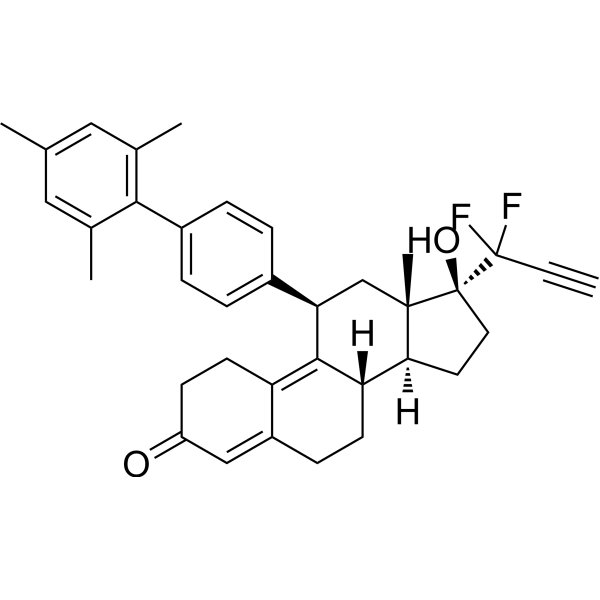Physicochemical Properties
| Molecular Formula | C36H38F2O2 |
| Molecular Weight | 540.682537555695 |
| Exact Mass | 540.283 |
| CAS # | 2012591-09-0 |
| PubChem CID | 139600278 |
| Appearance | Typically exists as solid at room temperature |
| LogP | 6.5 |
| Hydrogen Bond Donor Count | 1 |
| Hydrogen Bond Acceptor Count | 4 |
| Rotatable Bond Count | 3 |
| Heavy Atom Count | 40 |
| Complexity | 1140 |
| Defined Atom Stereocenter Count | 5 |
| SMILES | CC1=CC(=C(C(=C1)C)C2=CC=C(C=C2)[C@H]3C[C@]4([C@@H](CC[C@]4(C(C#C)(F)F)O)[C@H]5C3=C6CCC(=O)C=C6CC5)C)C |
| InChi Key | AHHXLJGAODIDAX-WQQPUSSASA-N |
| InChi Code | InChI=1S/C36H38F2O2/c1-6-36(37,38)35(40)16-15-31-29-13-11-26-19-27(39)12-14-28(26)33(29)30(20-34(31,35)5)24-7-9-25(10-8-24)32-22(3)17-21(2)18-23(32)4/h1,7-10,17-19,29-31,40H,11-16,20H2,2-5H3/t29-,30+,31-,34-,35-/m0/s1 |
| Chemical Name | (8S,11R,13S,14S,17S)-17-(1,1-difluoroprop-2-ynyl)-17-hydroxy-13-methyl-11-[4-(2,4,6-trimethylphenyl)phenyl]-1,2,6,7,8,11,12,14,15,16-decahydrocyclopenta[a]phenanthren-3-one |
| HS Tariff Code | 2934.99.9001 |
| Storage |
Powder-20°C 3 years 4°C 2 years In solvent -80°C 6 months -20°C 1 month |
| Shipping Condition | Room temperature (This product is stable at ambient temperature for a few days during ordinary shipping and time spent in Customs) |
Biological Activity
| Targets | Kd: 10.2 nM (leukemia inhibitory factor receptor)[1] |
| ln Vitro | In a dose-dependent way, EC359 (0-100 nM; 3 days) treatment decreases cell viability in BT-549, SUM-159, MDA-MB-231, MDA-MB-468, and HCC1806 cells[1]. Caspasese-3/7 activity and Annexin V-positive cells in MDA-MB-231 and BT-549 cells are markedly increased by EC359 (20 nM, 25 nM; 72 hours). TNBC cells undergo apoptosis when exposed to EC359, which inhibits invasion significantly[1]. Many known STAT3 target genes, including STAT1, TGFB1, JUNB, MCL-1, and others, have markedly decreased expression when exposed to EC359 (100 nM; 12 hours; BT549 cells)[1]. Significantly lessening STAT3 activation by LIF, OSM, and CNTF, EC359 (100 nM; 1 hour; MDA-MB-231 and BT-549 cells) therapy also does so. AKT, mTOR, S6, and ERK1/2 phosphorylation in MDA-MB231 and BT-549 cells is significantly reduced by EC359 therapy. Phosphorylation of proapoptotic p38MAPK in BT549 cells is likewise increased by EC359 treatment[1]. |
| ln Vivo | Treatment with EC359 (5 mg/kg; subcutaneous injection; three days a week; for 25 days; female athymic nude mice) dramatically slowed the growth of the tumor. The mice's body weights in the EC359-treated groups do not vary, indicating that EC359 is not very toxic[1]. |
| Cell Assay |
Cell Viability Assay[1] Cell Types: BT-549, SUM-159, MDA-MB-231, MDA-MB-468, and HCC1806 cells Tested Concentrations: 0 nM, 1.5 nM, 12.5 nM, 25 nM, 50 nM, 100 nM Incubation Duration: 3 days Experimental Results: decreased cell viability in a dose-dependent manner. Apoptosis Analysis[1] Cell Types: MDA-MB-231 and BT-549 cells Tested Concentrations: 20 nM, 25 nM Incubation Duration: 72 hrs (hours) Experimental Results: Promoted apoptosis of TNBC cells. RT-PCR[1] Cell Types: BT549 cells Tested Concentrations: 100 nM Incubation Duration: 12 hrs (hours) Experimental Results: decreased the expression of several known STAT3 target genes. Western Blot Analysis [1] Cell Types: MDA-MB-231 and BT-549 cells Tested Concentrations: 100 nM Incubation Duration: 1 hour Experimental Results: Substantially decreased the LIF activation of STAT3, decreased the STAT3 activation by OSM and CNTF, diminished the phosphorylation of AKT, mTOR, S6, and ERK1/2 in both BT-549 and MDA-MB-231 cells and increased the phosphorylation of proapoptotic p38MAPK in BT549 cells. |
| Animal Protocol |
Animal/Disease Models: 8weeks old female athymic nude mice with MDA-MB-231 cells[1] Doses: 5 mg/kg Route of Administration: subcutaneous (sc)injection; 3 days per week; for 25 days Experimental Results: Dramatically diminished the tumor progression. |
| References | [1]. Viswanadhapalli S, et al. EC359: A First-in-Class Small-Molecule Inhibitor for Targeting Oncogenic LIFR Signaling in Triple-Negative Breast Cancer. Mol Cancer Ther. 2019 Aug;18(8):1341-1354. |
Solubility Data
| Solubility (In Vitro) | DMSO : 125 mg/mL (231.19 mM) |
| Solubility (In Vivo) |
Solubility in Formulation 1: ≥ 2.08 mg/mL (3.85 mM) (saturation unknown) in 10% DMSO + 40% PEG300 + 5% Tween80 + 45% Saline (add these co-solvents sequentially from left to right, and one by one), clear solution. For example, if 1 mL of working solution is to be prepared, you can add 100 μL of 20.8 mg/mL clear DMSO stock solution to 400 μL PEG300 and mix evenly; then add 50 μL Tween-80 to the above solution and mix evenly; then add 450 μL normal saline to adjust the volume to 1 mL. Preparation of saline: Dissolve 0.9 g of sodium chloride in 100 mL ddH₂ O to obtain a clear solution. Solubility in Formulation 2: ≥ 2.08 mg/mL (3.85 mM) (saturation unknown) in 10% DMSO + 90% Corn Oil (add these co-solvents sequentially from left to right, and one by one), clear solution. For example, if 1 mL of working solution is to be prepared, you can add 100 μL of 20.8 mg/mL clear DMSO stock solution to 900 μL of corn oil and mix evenly. (Please use freshly prepared in vivo formulations for optimal results.) |
| Preparing Stock Solutions | 1 mg | 5 mg | 10 mg | |
| 1 mM | 1.8495 mL | 9.2476 mL | 18.4952 mL | |
| 5 mM | 0.3699 mL | 1.8495 mL | 3.6990 mL | |
| 10 mM | 0.1850 mL | 0.9248 mL | 1.8495 mL |
